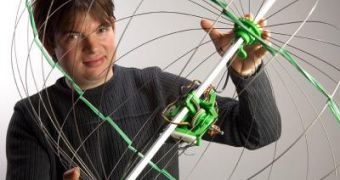Besides the composition of the atmosphere and the structure and features of the surface, the toughest challenge that an alien planet poses to exploration initiatives is known to be the way its terrain is shaped. This is what slowed down or even trapped the Martian rovers, and what has caused scientists to scratch their heads searching for solutions every time the surface exploration of a new cosmic body has come into question. However, a PhD student from the University of Bath thinks he has found a way to help them.
Biomimetics researcher Rhodri Armour and his team from the Center for Biomimetic and Natural Technologies at the University of Bath in UK have come up with a robot, called Jollbot, that is able to roll on smooth ground, as well as jump over obstacles. The developers hope that their creation could soon improve the space and planetary exploration, and land survey efforts in the near future. Legged robots are too complicate and expensive, and present maneuverability issues, as do wheeled ones, which can also bypass obstacles of limited size.
The Jollbot, though, can roll in any direction, at any given time, so trenches should not pose much problems. If they do appear too long to be rolled along, there's always the option of jumping, and since it's flexible and small (weighing less than a kilogram), it suffers no damage when landing, which also makes it cheaper to build.
"In nature there are two main types of jumping: hopping, like a kangaroo, which uses its fine control and direct muscle action to propel it along; and 'pause and leap', such as in a grasshopper, which stores muscle energy in spring-like elements and rapidly releases it to make the jump. We've made a robot that jumps in a similar way to the grasshopper, but uses electrical motors to slowly store the energy needed to leap in its springy skeleton," explained Armour, cited by PhysOrg.
"Before jumping, the robot squashes its spherical shape. When it is ready, it releases the stored energy all at once to jump to heights of up to half a meter. Future prototypes could include a stretchy skin covered in solar cells on the outside of the robot, so it could power itself, and robotic control sensors to enable it to sense its environment," he added.

 14 DAY TRIAL //
14 DAY TRIAL //